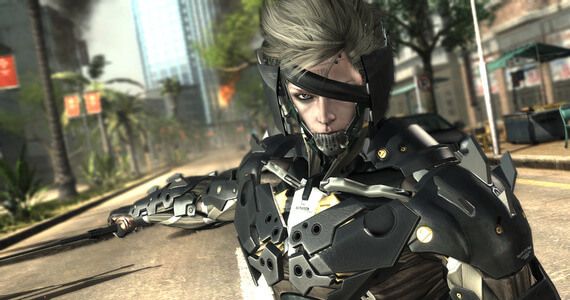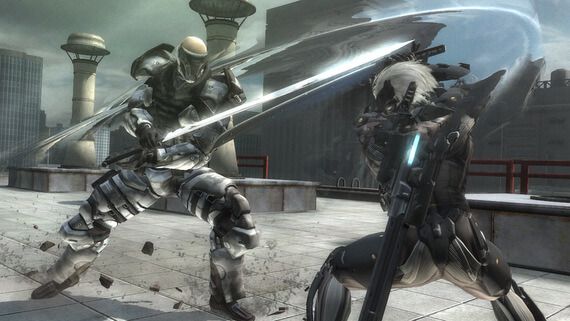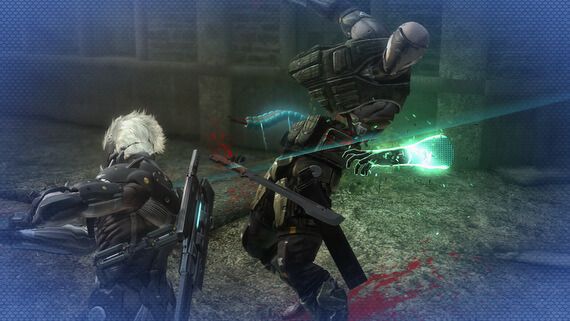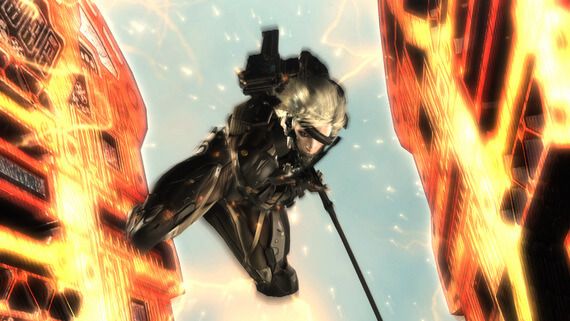Rare is the game that manages to find room for a frivolous Teenage Mutant Ninja Turtles reference and a serious discourse on how euphemistic language is employed to emotionally sanitize the atrocities mankind commits in the world. Both can be found in Metal Gear Rising: Revengeance, a hyper-kinetic, action-focused offshoot of Hideo Kojima's venerable Metal Gear series, developed by Platinum Games (Bayonetta, Vanquish) under the direction of Kojima Productions. Is Revengeance a successful fusion of its creators' disparate sensibilities? Read on for Game Rant's full review of Metal Gear Rising: Revengeance.
Revengeance certainly makes an impression. Lethal cyborg protagonist, Raiden, "disguised" in a comically oversized sombrero and poncho. References to, among other things, Star Trek II: The Wrath of Khan and This Is Spinal Tap, plus Neal Shusterman's novel Unwind, and the aftermath of the September 11th attacks. Slicing an enemy precisely in half, then yanking a cybernetic spine full of luminescent blue gel from the bifurcated corpse, well before either flailing hemisphere hits the ground. Intensely frustrating difficulty spikes. A weapon made from shiny, little, rubber-clad arms.
Metal Gear Rising: Revengeance is full to bursting with literate pop-culture allusions and heated political debate, moments of nearly unequaled action gaming badassery, and genial goofiness. It's a fever-dream of a game that, nonetheless, is mechanically sharp and pointedly accessible for much of its playtime.
The heart of the game is given over to its combat mechanics, which are shopworn and innovative in nearly equal measure. With just two basic attacks, light and strong, Platinum has crafted an easy-to-grasp, flexible combat system that rewards precision but is forgiving of button-mashing. Average encounters against average enemies - which, thankfully, do not make up a disproportionate amount of the game's campaign - can leave players feeling enormously powerful, bordering on the unstoppable. Had that been the extent of Revengeance's combat options, the game would still be fun to play. The addition of Blade Mode, however, changes nearly everything.
In Blade Mode, time slows to a crawl. Raiden can surgically pinpoint any part of a foe: limbs can be severed (left arms are particularly coveted), and heads can be lopped right off. Enemies who have already sustained sufficient damage display a small red target; slice through it to reveal that glowing blue spine. Snatching the cyber-spine not only restores Raiden's health and energy, but brings a prompt end to the encounter.
Initially, hitting that target or chopping off a specific limb can be hard to reliably accomplish. The plane of Raiden's attack can be adjusted to any desired angle, but in the heat of battle - and with time in Blade Mode limited - it can be tricky to properly finesse. One too many swings of the high frequency katana blade leaves a pile of hamburger where an opponent used to be - though, admittedly, that can fun in its own right. For that matter, much of the environment can be similarly dismantled. Chopping an abandoned car into a thousand tiny pieces definitely has its charm.
That charm fades a bit when remnants of decimated architecture clog up the battlefield, impeding Raiden's mobility. It happens in routine encounters, but becomes more of a problem during the game's frequent boss battles. For that matter, there is little rhyme or reason to which environmental objects are prone to destruction: a towering overpass might come down with a few quick slices, while a windowed storefront remains impervious. Fortunately, it's easy enough to identify the game's destructible elements. Raiden can view an augmented version of the world (think Arkham City's Detective Mode, though combat nullifies the effect) that clearly identifies which objects can be cut up, in addition to revealing hidden power-ups and any waiting enemies.
Aside from the occasional hang-up on hacked apart elements of the environment, traversal is one of Revengeance's real strengths. Ninja Run allows Raiden to automatically jump over obstacles, slide under impediments and nimbly avoid laser alarm systems - to say nothing of the machine gun fire that results from tripping them. Raiden can still attack while running, and gains a nifty, endlessly useful offensive slide in the process. More than anything, Ninja Run makes Raiden an elusive target, which helps keep him alive during boss encounters. That being said, the few showpiece sequences that hinge on Ninja Run - especially Raiden racing up through a building that is under ferocious assault from the outside - are among the game's absolute high points.
Then there are the bosses. Revengeance is certainly not hurting for boss battles, which make up a significant portion of its playtime. Some of Raiden's eventual opponents are revealed in the earliest stages of the game; others come out of nowhere. Regardless, every encounter is unique, and every boss is distinct (though, disappointingly, a gauntlet of previously defeated bosses does appear at one point in the game).
Appropriately, the initial battles are practically tutorials. Later battles can be downright punishing: exciting, pulse-pounding, and occasionally frustrating as Hell. A few key battles leave practically no room for error. Players must carefully assess the encounter, come up with an appropriate strategy, and execute flawlessly (which, in practical terms, means fighting the boss again, and again, and again). None of these conflicts are insurmountable, but the precision required to prevail is definitely at odds with the bulk of Revengeance which, again, is not unkind to button-mashers. To be clear, some bosses are veritable pushovers - even late in the game - but a few thorny encounters rough up Revengeance's otherwise smooth progression.
There is a third major component to the Metal Gear Rising experience: cinematics. A lot of them. Between missions, between discreet areas of a given stage, even during those many boss battles, Revengeance is a talky, story-heavy game that isn't shy about engaging in political debate. For action hungry gamers, some of these interludes are sure to be a turn-off. Others are over-the-top to the point of hilarity - absurd, fist-pumping hilarity (often), but hilarity just the same. The novelty of Rising's story deserves to be experienced fresh, so no spoilers here. Suffice it to say that the game's voice acting is mostly solid and its localization (by 8-4, Ltd.) is sterling. On the other hand, the soft focus and occasional compression artifacts in the rendered cinemas mark them as less impressive than Revengeance's generally excellent in-game graphics.
It's remarkable how clearly Metal Gear Rising: Revengeance reflects the sensibilities of both Platinum Games and Kojima Productions. This truly is a game neither studio could have produced on its own. That said, it's fair to wonder who, exactly, the audience for Revengeance is. Action game junkies are apt to be put off by the verbose, referential weirdness of the experience, while gamers who prize those qualities just might not be able to hang with the more mechanically demanding (read: frustrating) parts of the game. Their loss. Revengeance's dichotomy is a strength, not a defect. Its idiosyncratic narrative and gameplay elements reinforce - rather than dilute - one another. Almost by design, Metal Gear Rising won't be for everyone. But, for even the remotely curious, it earns an easy recommendation.
Metal Gear Rising: Revengeance is available now for PS3 and Xbox 360. Game Rant reviewed the Xbox 360 version of the game.
-
Follow me on Twitter @HakenGaken.




